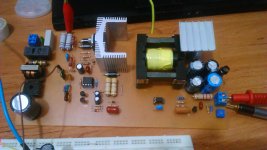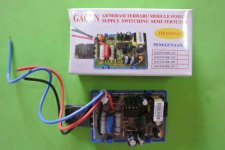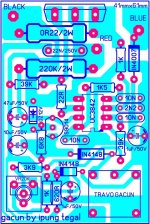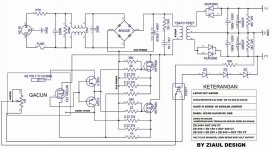kooroshi60
Member
I have built this power supply but I can't figure out the correct number of turns for the transformer. here is the PDF schematic:
View attachment Fly-Back 13.8v 10A.pdf

This SMPS is based on UC3842 controller and is supposed to work with 220V and the output voltage is 13.8 Volts at 8 Amps.
This is my first Flyback and it is actually a clone of this Industrial SMPS you can see here:
http://danyk.cz/reverz44_en.html
Before this I had made several Half bridge SMPS based on IR2153 using the ExcellentIT ver. 7100 calculator easily. But this one seems like a nightmare.
I tried an approximate winding of "40 turns for Primary" , "20 turns for Secondary" and "20 turns for auxiliary" and it worked when the input voltage was 95 volts.
With 220 volts, transformer started clicking really badly and also the output voltage was too low and not stable.
It is really frustrating I really can't figure out the winding turns. Would you guys please help with the transformer design?
Here are some details about the circuit:
Core : EDT-39 (effective area = 12.5cm square / effective lenght = 92.2 mm)
Transistor: 2SK2645 (600V 9A RDSon = 1.2 ohm)
Output Diode : MBR20100 ( 100v , 20A , VF=.95 volt)
Input voltage: 220 volt
Output: 13.8 Volts 8 Amps
Thank you
Any help is highly appreciated
View attachment Fly-Back 13.8v 10A.pdf

This SMPS is based on UC3842 controller and is supposed to work with 220V and the output voltage is 13.8 Volts at 8 Amps.
This is my first Flyback and it is actually a clone of this Industrial SMPS you can see here:
http://danyk.cz/reverz44_en.html
Before this I had made several Half bridge SMPS based on IR2153 using the ExcellentIT ver. 7100 calculator easily. But this one seems like a nightmare.
I tried an approximate winding of "40 turns for Primary" , "20 turns for Secondary" and "20 turns for auxiliary" and it worked when the input voltage was 95 volts.
With 220 volts, transformer started clicking really badly and also the output voltage was too low and not stable.
It is really frustrating I really can't figure out the winding turns. Would you guys please help with the transformer design?
Here are some details about the circuit:
Core : EDT-39 (effective area = 12.5cm square / effective lenght = 92.2 mm)
Transistor: 2SK2645 (600V 9A RDSon = 1.2 ohm)
Output Diode : MBR20100 ( 100v , 20A , VF=.95 volt)
Input voltage: 220 volt
Output: 13.8 Volts 8 Amps
Thank you
Any help is highly appreciated



